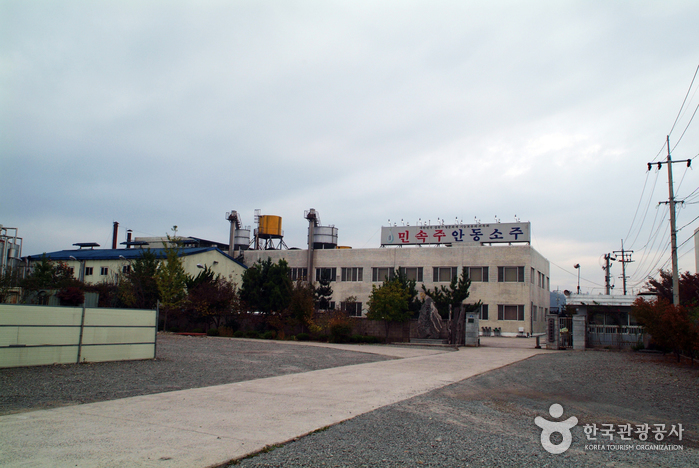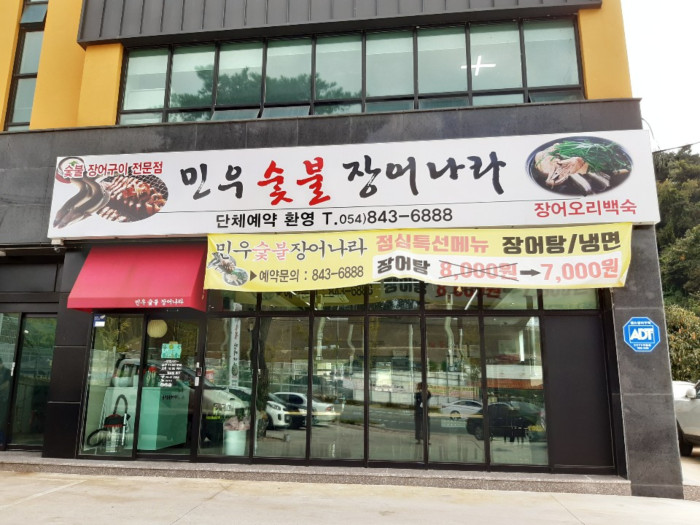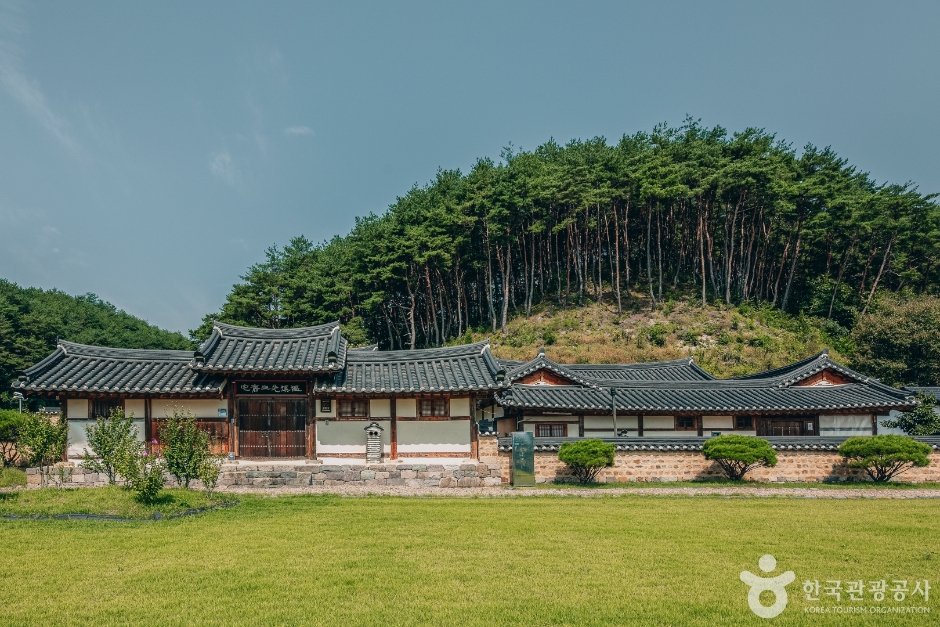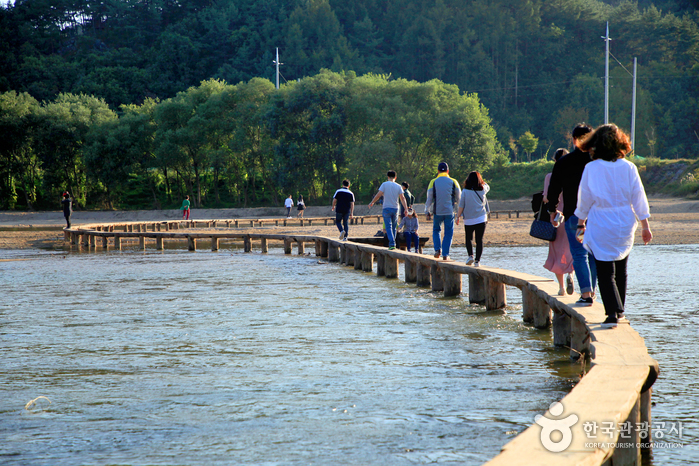Gyeongbokgung (경복궁)
10.4Km 2024-03-08
4439 Chunghyo-ro, Andong-si, Gyeongsangbuk-do
Gyeongbokgung is a restaurant specializing in Korean beef cuisine. Popular menu items include hanu yukhoe bibimbap (Korean beef tartare bibimbap) and hanu gui (grilled Korean beef). They offer neatly prepared side dishes made with fresh seasonal ingredients, and they are renowned for the delicious taste of their food. Located near Andong Hahoe Village and Andong City Hall, there are plenty of attractions nearby.
E-Mart - Andong Branch [Tax Refund Shop] (이마트 안동)
10.8Km 2024-04-22
2, Okdong 1-gil, Andong-si, Gyeongsangbuk-do
-
Andong Soju & Traditional Food Museum (안동소주·전통음식 박물관)
11.2Km 2021-12-01
71-1, Gangnam-ro, Andong-si, Gyeongsangbuk-do
+82-54-858-4541
Andong Soju & Traditional Food Museum was established in 1995 to promote and pass down the history and cultural characteristics of Andong Soju (Gyeongsangbuk-do Intangible Heritage). Andong Soju is a liquor distilled from wheat with 45 percent ABV that originated during Silla period. This regional liquor became widely known outside of Andong when the Korean government strongly supported the development of regional liquors in anticipation of the Asian Games in 1986 and Seoul Olympic Games in 1988.
Minu Sutbul Jangeo Nara(민우숯불장어나라)
11.4Km 2025-08-01
24, Gwangmyeong-ro, Andong-si, Gyeongsangbuk-do
+82-54-843-6888
This is a place where you can enjoy healthy eel dishes. The best menu at this restaurant is grilled eel. This Korean dishes restaurant is located in Andong-si, Gyeongsangbuk-do.
Andong Hospital (안동병원)
11.8Km 2025-10-23
11 Angsil-ro, Andong-si, Gyeongsangbuk-do
Founded in 1982 in Andong-si, Andong Hospital is a general hospital and a member organization of Andong Medical Group Hospital.
We operate several specialized centers designated or certified by the Korean Ministry of Health and Welfare (e.g., Regional Emergency Center, Air Ambulance Helicopter, Integrated Cancer Center, Regional Cardio-Cerebrovascular Disease Center (RCDC), Spine and Joint Center, Clinical Trial Center, and Robotic Surgery Center).
Within the Andong Medical Foundation are Andong Hospital, Andong Nursing Hospital, Yongsang Andong Hospital, and Andong Hospital Specialized Care Center so that patients can receive connected care at general acute care hospitals, nursing hospitals, and nursing homes.
Andong Medical Group Hospital oversees Andong Hospital, Andong Convalescent Hospital, and Yongsang Andong Hospital. This allows patients to receive coordinated care at general acute care hospitals, convalescent hospitals, and nursing homes.
Dosanseowon Confucian Academy [UNESCO World Heritage] (도산서원 [유네스코 세계유산])
11.9Km 2025-10-23
154 Dosanseowon-gil, Andong-si, Gyeongsangbuk-do
+82-54-856-1073
In terms of architecture, Dosanseowon Confucian Academy complex can largely be divided into Dosanseodang compound and Dosanseowon compound. Dosanseodang area consists of living quarters and lecture halls where Toegye Yi Hwang, an eminent Confucian scholar, lived and taught his students. Dosanseowon was built after Toegye Yi Hwang passed away by his followers' to honor the legacy of his teachings as well as to pay respects to the deceased.
Built in 1561, Dosanseodang lecture hall is the oldest building in the whole complex. It was personally designed by Yi Hwang, penname Toegye, to further his studies while educating future scholars after moving to the countryside. Living quarters used as a student dormitory were also built along with the lecture hall.
Dosanseowon compound was completed in 1576, six years after Yi Hwang's death. Yi Hwang's ancestral tablet was enshrined inside Sangdeoksa Shrine in 1572. Two years later, Jeongyodang Lecture Hall was built to relocate the tablet and with the addition of buildings to the hall's east and west, the area became a seowon. In 1575, the establishment was bestowed a royal charter and a plaque with the name Dosanseowon written by Han Seok-bong, and became the Confucian academy headquarters in the Yeongnam region.
◎ Travel information to meet Hallyu’s charm - variety show"I Am Solo"
This is where participants were dressed in hanbok and matched with a partner based solely on the color of their clothes, regardless of their will. Each time they were matched, viewers felt excitement and tension as if they were being matched themselves. Follow the hiking trails around the academy to see notable monuments like a massive willow tree, and Sisadan Stele.
Nosongjeong Head House (노송정종택(퇴계생가))
13.4Km 2024-12-13
46-5 , Onhyejungma-gil, Andong-si, Gyeongsangbuk-do
+82-54-856-1052
Nosongjeong Head House is located in Dosan-myeon, Andong, Gyeongsangbuk-do and is the birthplace of Toegye Yi Hwang. The room in which Toegye Yi Hwang was born is known as Toegye Taesil, and it is uniquely designed in the shape of a castle with banisters covering three sides of the center. There are seven guest rooms, including keun sarangchae (large detached building) and chaekbang (study), and a bathroom in anbang (main room). Nosongjeong Pavilion consists of two large rooms with a maru equivalent of a wide wooden-floored area, and the bathroom and shower are outside. Guests staying in the upper room, lower room, large room, and small room also have to use the outdoor bathroom. Nearby are historic sites such as the Dosanseowon Confucian Academy, Cheongnyangsa Temple, and Gukmangbong Peak.
On-gye Jongtaeg (Sambaegdang) / 온계종택 삼백당
13.5Km 2025-03-04
20 , Onhyejungma-gil, Andong-si, Gyeongsangbuk-do
+82-10-8704-3434, +82-10-2988-3435
Ongye Jongtaek Sambaekdang in Andong, Gyeongsangbuk-do, is a restored hanok and original home of Ongye Lee Hae, the older brother of the famous Toegye Lee Hwang. Right outside the hanok stands a 500-year-old chestnut tree, symbolic guardian of the village. Some guestrooms have bathrooms with toilet, while some have AC. The shower room, laundry room, kitchen, storage room, and wood-floor sitting room are shared. For groups of 10 or more, an outdoor barbecue can be arranged - but inquire ahead. Visitors who book in advance can take part in handicraft programs such as tea-bag making.
Hakgasan Recreational Forest (학가산자연휴양림)
15.8Km 2021-06-15
210, Hyuyangnim-gil, Yecheon-gun, Gyeongsangbuk-do
+82-54-652-0114
Hakgasan Recreational Forest is located in a valley on the northern side of Hakgasan Mountain, known for its clean air. The recreational forest has log cabins that harmonize with the nearby trees, creeks, and rocks, making visitors feel as if they are resting at a luxury villa. It is an ideal vacation destination for those who want to get closer to nature. There is a hiking path leading to the summit of Hakgasan Mountain from the forest, taking around 2 hours. Additional amenities within the forest include campfire pits, an outdoor stage, children's playground, exercise equipment, water play area, a lecture hall, and more.
Yeongju Museom Village (영주 무섬마을)
16.2Km 2021-08-24
31-12, Museom-ro 234beon-gil, Yeongju-si, Gyeongsangbuk-do
+82-54-638-1127
Located in Sudo-ri in Yeongju, Gyeongsangbuk-do, Museom Village is a charming hanok village surrounded by water. Flowing down from Sobaeksan Mountain and Taebaeksan Mountain, Naeseongcheon Stream and Yeongjucheon Stream converge and loop around Museom Village, surrounding the village on three sides with water. This peninsula-like village is not only the center of traditional Korean culture, but also has a gorgeous natural landscape complete with a wide sandy riverside and a lush inland forest.
Known for Haeudang and Manjukje Houses (two of the most historical hanok houses in the area), the village is also home to other outstanding traditional houses such as the Kim Gyu-jin House and the Kim Wi-jin House. Manjukje House is located at the heart of the village and the oldest traditional house in this hanok village. Manjukje was built in 1666 (7th year of King Heonjong's reign) by Bak Su (the father of the Bannam Bak Family).
Nearby Manjukje is Manun House, built in the early 19th century and named after Kim Hwi-geol (penname “Manun”). The house later became the home of the wife of the famous poet Jo Ji-hun, author of “Byeolli,” a poem expressing the beauty of Museom Village.
Other notable houses include the Kim Wi-jin House (a house belonging to aristocrats), the Kim Jeong-gyu House (a house without the traditional outer fencing), and the Bak Jae-yeon House, where the writings of Bak Gyu-su (a respected scholar during the Joseon period) still remain today.
Another famous attraction in the village is the Single Log Bridge, which was the village’s only connection to the outside world for over 350 years before the construction of Sudo Bridge in 1979. It is a tiny bridge in terms of x_width (30 cm), but it stretches for over 150 meters. It is said that the bridge was rebuilt annually after being destroyed each rainy season. With the construction of Sudo Bridge, the Single Log Bridge was no longer needed, but was rebuilt some time later in its original form. To celebrate the bridge’s impressive history, the village hosts the Single-Log Bridge Festival every October.

![E-Mart - Andong Branch [Tax Refund Shop] (이마트 안동)](http://tong.visitkorea.or.kr/cms/resource/31/2883731_image2_1.jpg)


![Dosanseowon Confucian Academy [UNESCO World Heritage] (도산서원 [유네스코 세계유산])](http://tong.visitkorea.or.kr/cms/resource/24/3437624_image2_1.png)



 English
English
 한국어
한국어 日本語
日本語 中文(简体)
中文(简体) Deutsch
Deutsch Français
Français Español
Español Русский
Русский